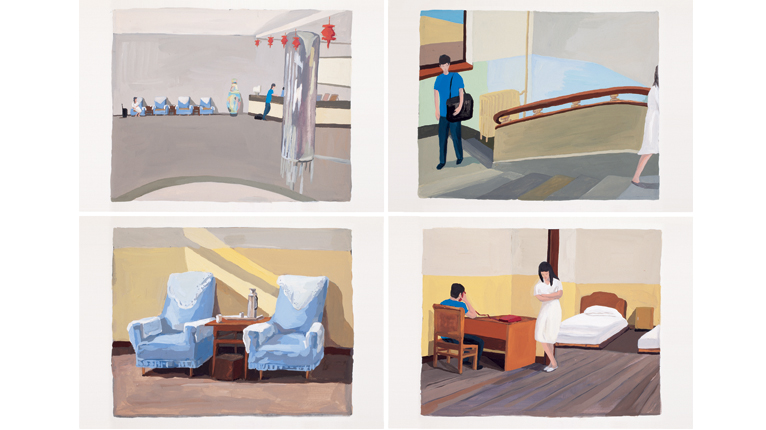LIU XIAOHUI’S PAINTINGS
| July 26, 2012 | Post In LEAP 15

“I regard these paintings more as information bulletins reporting on this particular period of my life,” Liu Xiaohui writes in the introduction to this exhibition. Life has certainly been the central theme in Liu’s recent work, and a narration of its ordinariness and accidental nature clearly guides the style of this series of paintings. In The Daily Life of a Father, Liu turns to the particulars of life in sketches and descriptions; meanwhile, the gray tones and use of tempera in “The Female Body” series laterally hint toward his position as a teacher at the Central Academy of Fine Arts, embodying the artist’s many years of experience within the Academy.
But the “life” depicted in Liu Xiaohui’s paintings is not merely characterized by “faithful” recording. At the exhibition and in the book published alongside it, three series of paintings take as their theme “the day of a model.” These series take the artist’s own life experiences as their point of departure, then proceed to different levels of psychological association. The information contained within the work is taken from everyday scenarios, objects, and people related to the artist. But on a narrative level they are neither governed by a contrived model nor by a detached, omniscient “creator,” but rather by the inevitable subjectivity of the artist himself. Each plot has been painstakingly articulated, the ruptures between each artificially omitted so that each individual work is able to exist independently. Here, Liu is more of a manipulator, using a painterly approach to construct cohesive plots from existing collections of images.
The “Youyi Hotel” series occupies the most prominent position in the gallery. Its ten small paintings, displayed in a rectangular ashwood frame, tell the story of a man and a woman in a hotel. The setting portrayed in the paintings derives from an experience the artist had while traveling in Lanzhou; the heavily nostalgic feel of the furnishings seem to accord the events of the “story” an appropriate setting. The plot, meanwhile, is mostly borrowed from the artist’s memory, a narrative technique he often employs. Although Liu has always sought to use the appropriate narrative techniques in his paintings, they appear serialized, much like a graphic novel. They are free of overtly literary tendencies, and also remain distinct from the montage techniques of cinema— the audience is given no opportunity to discover the relationship between the two characters of “Youyi Hotel,” and the cause of their dispute is also left unclear. Indeed, in the very plain account that unfolds across the paintings, all that can be deduced is the ongoing state of affairs and a few minor details. The narratives contained within Liu’s paintings are stripped of all theatricality and possess none of the assumed literary techniques commonly found in classical painting. Rather, the subject of the plot is isolated and drawn out, the painting left only with pure, untainted archetypes. This allows the still-life scenes to develop dynamic relationships amongst themselves, granting the audience the freedom to project their own imagination onto its framework.
The same approach is used in the series titled “Chongqing Cable Car Ride,” only in this instance it is further abstracted. The first few paintings of the series meticulously create an atmosphere of suspense through the depiction of empty scenarios, either completely stripped of human presence, or featuring only brief appearances in the corner of a painting. The stream of paintings which follow turn their focus on a dog, which culminates in the depiction of an awe-inspiring canine statue: viewers may instantly make the connection to Hachiko, the famous dog of modern Japanese lore. Confronted outright with the quotidian, the audience might also unwittingly apply personal frameworks of understanding to their interpretation of these paintings, the emerging poetic resonances of which are the exact result of the reaction produced when the experiences of two sides encounter each other in this way. Zhao Mengsha (Translated by Dominik Salter Dvorak)

